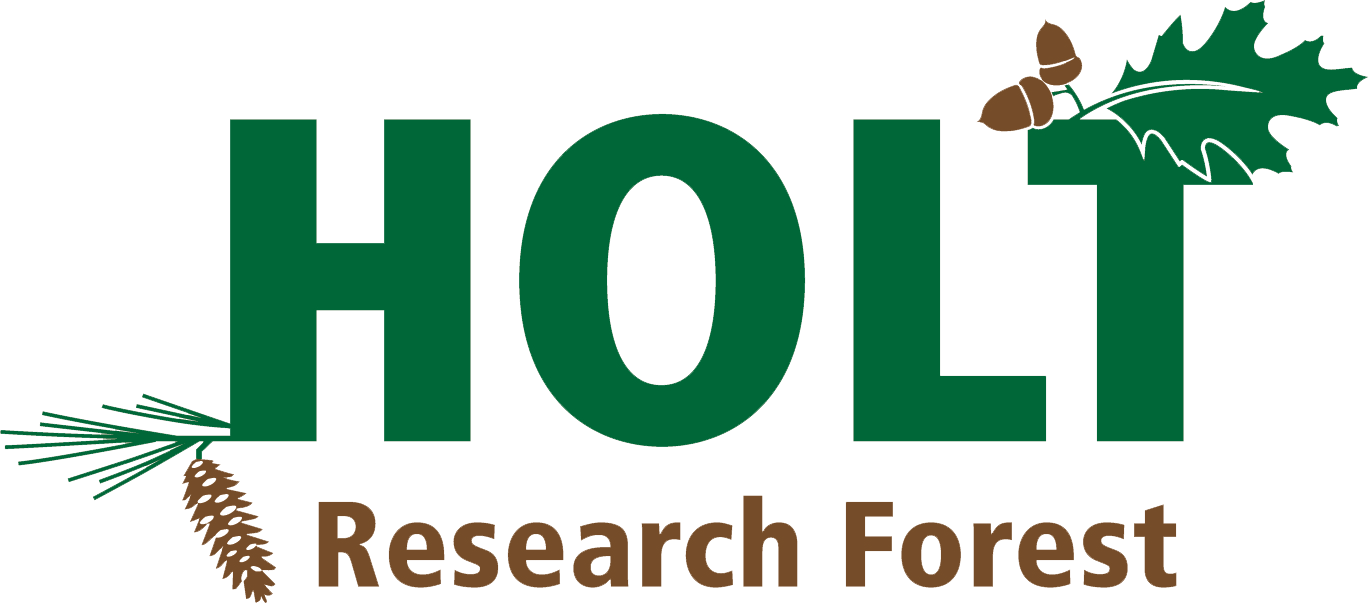The Holt Research Forest is the site of long-term forest ecosystem research in Arrowsic, Maine. Maine TREE acquired the 350-acre property in 2014 through a merger with the Holt Woodland Research Foundation. The woods are predominantly a dry ridge, oak-pine ecosystem, in Maine’s coastal climatic and midcoast biophysical regions.
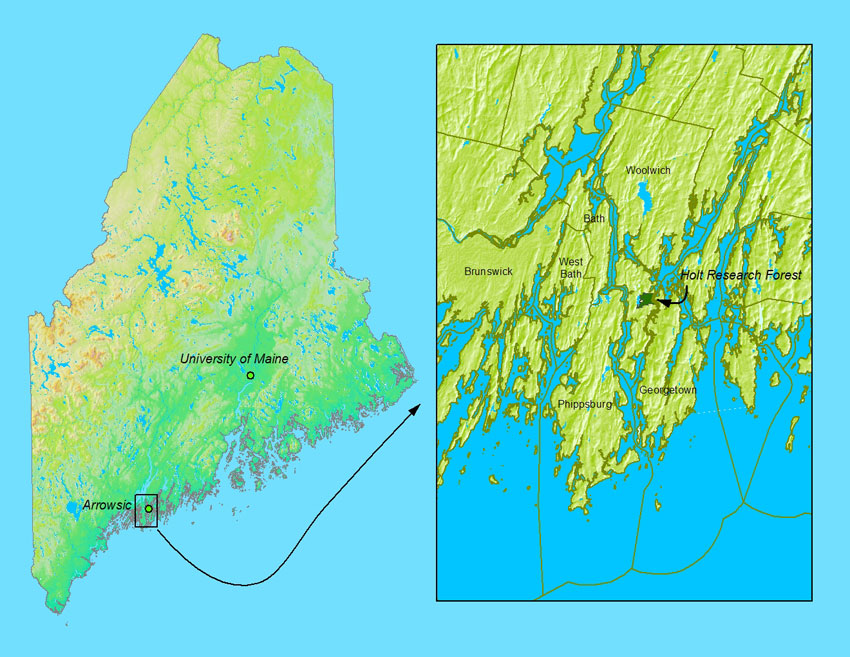
History
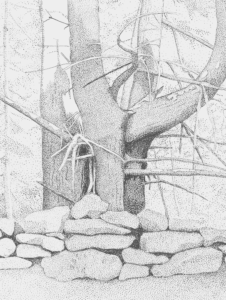
Parts of the Holt Research Forest (HRF) property were farmed from the late 1600s to the 1940s. Aerial photos from 1940 show a distinct difference in forest stand types along an old east-west property/fence line. Remnants of stone walls, building foundations, and wire fencing are still visible. This former property line divides the area into north and south halves.
William (Bill) and Winifred Holt bought the south farm in 1941 and the north farm in 1946 and added several additional parcels. Over the next four decades, land management was minimal. Jeep trails to the Back River and Sewell Pond were maintained. Bill Holt planted some white pines in abandoned agricultural areas and removed some firewood and dead and dying trees. Click here for more about the land use history.
In 1981 the Holt family offered the use of the property to the University of Maine for research, under the auspices of the Holt Woodlands Research Foundation (HWRF). The Foundation was endowed by Rod Holt whose generosity and dedication to HRF continues today.
After some exploratory inventories (see 1982 Natural Resource Inventory), in 1983 the project began in earnest with the pursuit of forest management and research goals.
HWRF constructed a research facility on the site of an abandoned well and cellar hole. A log house was built in 1983 from white pine, spruce, and hemlock harvested from the area just east of the site to become the residence for the on-site scientist/ property manager. A two-story garage was built in 1987 for equipment storage, work area, with the second floor serving initially as housing but now primarily as office space. Currently accommodations for visiting scientists or students are limited.


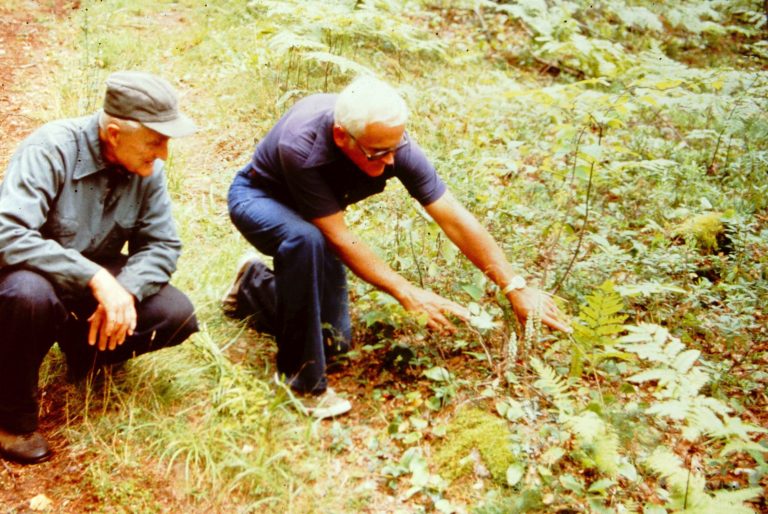
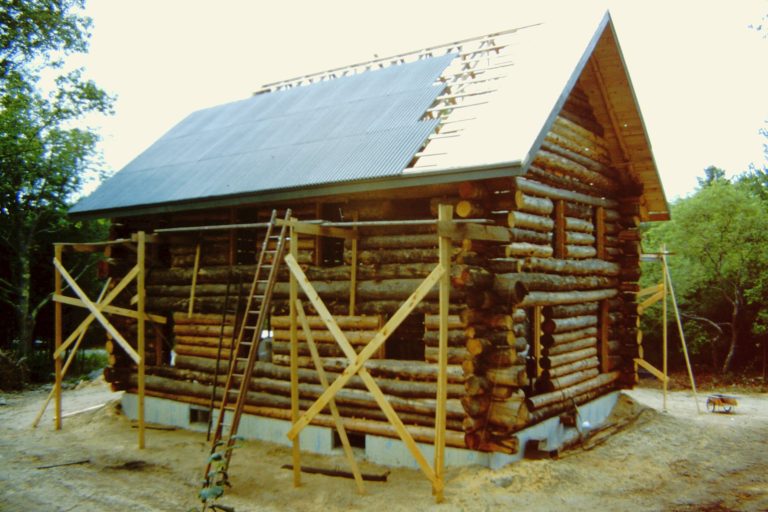
In 2014 the Holt Woodlands Research Foundation ceased to exist by merger with the Maine TREE Foundation. The ongoing project continues with their support and guidance.
Forest Landscape
Landscape planning
Forest management is moving toward landscape-level planning to ensure the diversity and sustainability of working forests. Landscape management has typically been focused on huge tracts of public or industrial forest land. But now, outside of the northern forest, most of New England’s forest land exists as a mosaic of thousands of small (less than 5,000 acres), privately owned forest tracts, which require different strategies for landscape-level planning. The Holt Research Forest is demographically well-positioned to explore landscape-level approaches to planning and management in this fragmented ownership pattern.
Conservation
A concerted effort has been underway for some time to protect the water of the Kennebec Estuary from potentially damaging changes in the use of abutting uplands. A partnership of nonprofit conservation organizations including The Nature Conservancy, Maine Coast Heritage Trust, Kennebec Estuary Land Trust and others with state and federal agencies have conserved more than 10,000 acres in the Merrymeeting Bay/Kennebec Estuary region. This area is a focus area of statewide ecological significance as reflected by a Maine Beginning with Habitat publication (Will open pdf). This effort has included many generous donations of property and conservation easements and fee purchase with funds raised from a variety of sources such as the North American Wetlands Conservation Council (NAWCC), USFWS Coastal Wetlands Program, Land for Maine’s Future, as well as foundations and gifts from individuals.
The Holt Research Forest is protected by a conservation easement held by The Nature Conservancy. The easement allows research and management to continue while protecting the property from subdivision or development.
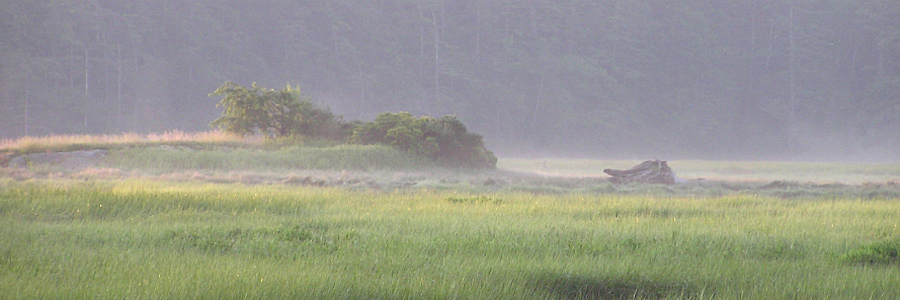
Though most acquisitions are specifically aimed at tidal wetlands and adjacent upland buffers, larger tracts are sometimes acquired. In close proximity to HRF, the 170-acre parcel to the south is owned by the Maine Department of Inland Fisheries and Wildlife and was one of the first in the region to be purchased with federal and state funds. The property to the north was donated to The Nature Conservancy. This and other lands along the Back River have been protected by purchase or conservation easements are forming a large area of mostly intact, undivided forest land. To date, more than 1,000 acres of Back River tidal marshes and uplands have been protected providing habitat for a wide diversity of species.
Climate Smart Forestry
Our friends at the US Forest Service put together case study about climate change and forestry operations at Holt Research Forest.
Videos
People
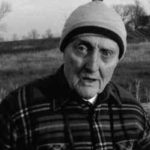
Work at the Holt Research Forest is dedicated to
Dr. William L. Holt Jr.
his wife, Winifred Holt
and their son, F. Rodney Holt.
These family members were the impetus for the creation of the Holt Woodlands Research Foundation and the Holt Research Forest. The Holts’ generosity, foresight, and commitment to forest research has been demonstrated repeatedly over the many years of this project.
Their past support of the Holt Research Forest has and will continue to provide benefits to students, logging, forestry, and wildlife professionals, forest landowners, and forest management in Maine. To this end, they have served us all.
Current & Past Investigators from the University of Maine
- Malcolm L. Hunter Jr., Libra Professor of Conservation Biology and Professor of Wildlife Ecology, Department of Wildlife, Fisheries, and Conservation Biology
- Laura Kenefic, Research Forester and Principal Silviculturist, U.S.D.A. Forest Service, Northeastern Research Station NE-4155 Ecology and Management of Northern Forest Ecosystems and Faculty Associate, School of Forest Resources
- Alan J. Kimball, Forest Manager, University Forests and Associate Professor of Forest Resources, School of Forest Resources (now retired)
- Jessica Leahy, Associate Professor of Human Dimensions of Natural Resources, School of Forest Resources & Interim Associate Dean for Research & Associate Director, Maine Agricultural and Forest Experiment Station
- Aaron Weiskittel, Associate Professor of Forest Biometrics and Modeling and Irving Chair of Forest Ecosystem Management, School of Forest Resources
- Alan S. White, Professor of Forest Ecology, School of Forest Resources (now retired)
On-site Staff
Jack W. Witham, Associate Scientist, School of Forest Resources
University of Maine Graduate Students
Dissertations:
- Steve Campbell (2007) Effects of a group selection harvest on the bird community of an oak-pine forest in Maine. Department of Wildlife Ecology, University of Maine, Orono.
- Karen E. McCracken (1996) Seed predation by small mammals on three species of trees in an oak-pine forest ecosystem. Ph.D. dissertation, Department of Wildlife Ecology, University of Maine, Orono. 107pp.
Theses:
- Martha E. Schumann (1999) The effects of harvest-created gaps on plant species diversity, composition, abundance, and growth in a Maine oak-pine forest. M.S. thesis, Department of Ecosystem Science, University of Maine, Orono. 179 pp.
- Laura M. Monti (1997) Redback salamander habitat preferences in a Maine oak-pine forest. M. S. Thesis, Department of Wildlife Ecology, University of Maine, Orono. 53 pp.
- Tamara L. Clark (1996) Stand development, growth patterns, and regeneration success of red oak in an oak-pine forest in southern Maine. M.S. thesis, Department of Ecosystem Science, University of Maine, Orono. 154 pp.
- Andy A. Whitman (1992) Frugivory and seed dispersal of fleshy-fruiting plants in a northern temperate forest. M. S. Thesis, Department of Wildlife Ecology, University of Maine, Orono. 214pp.
- Mary F. Small (1986) Response of songbirds and small mammals to powerline and river edges of Maine oak-pine forests. M.S. Thesis, Department of Wildlife Ecology, University of Maine, Orono. 58 pp.
Senior Honors Theses
Four undergraduates have prepared senior honors theses based on work they did at the Holt Research Forest: Martha Wood, Stuart Gardiner, Shawn Crawley, and David Ginsberg.
Research Assitants
Over one hundred graduate and undergraduate students, most from the University of Maine, have worked on the Holt Research Forest. Without their help, research and property management on the Holt would be impossible. They are, listed in chronological order:
- Mary Gaudette
- Don Barrett
- Bill Jarvis
- Mark Andrews
- Rich Vannozi
- Heather Almquist
- James Favereau
- Cheri Meinson
- Shawn Carlson
- David Kane
- Jeffrey Slahor
- Kathleen Meddleton
- Brian Peters
- Sally Stockwell
- Peter Wagner
- Ralph Keyes
- David Libby
- Mary K. Meimam
- Sharon Abrams
- Tina Stillings
- Jeremy Blaiklock
- Susan Bobowitz
- Steve Bongiorno
- Kim Figlar
- Cindy Garman
- Peter Reaman
- Tami Rudnicky
- Jim Rudnicky
- Stacy Proudman
- Amy Mehan
- Xiandong Meng
- Al Meister
- David Landry
- Tracey Walls
- Adam Carmichael
- Larry Lee
- Jeff Williams
- Sixto Garache
- Dan Scott
- Christine Petibou
- Scott Houle
- Carroll Cooper
- Michael Baer
- Melissa Laser
- Christine Wooley
- Brandon Mann
- Krishnan Sudharsan
- Bryan Swenson
- Catherine Galipeau
- Jennifer Watkinson
- Roxanne Burrus
- Tracey Daras
- Gregory Stevens
- Jeremy Tardif
- Dawn Nelson
- Brenda Bilotta
- Rebecca Garrahan
- Holly Robertson
- Gina Purtell
- Walter Veselka
- Brad Friebel
- Judith Scarl
- Christina Thompson
- Shane Gauber
- Matt Montgomery
- Seth Rifkin
- David Ginsberg
- Alex Stace
- Emily LaPlante
- Katie Manende
- Rich Lucas
- Jamie Weaver
- Cassandra Pease
- Peter McBride
- Rebecca Clark
- Nicole Rogers
- Violet Wood
- Oliver Watkinson
- Eli Shank
- Eric Berube
- Karen Purinton
- Hugh Valaitis
- Norah Young
- Anna Jaegar
- Trevor Cordwell
- Nolan Steele
- Lucas Lamond
- Paige Howell
- Daniell Wyman
- Henry Amponsah
- Meredith Melendy
- Jordan Goodstein
- Autumn Brann
- Joshua Gibson
- Robert Hart
- Nathaniel Harris
- Jasmine Gregory
- Emily Roth
- Andrew Kooken
- Gia Francis
- Noah Smith
Thank you, Assistants, one and all! Apologies to any we missed.
